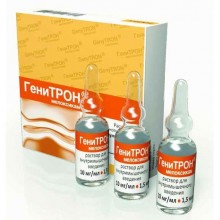



Meloxicam is a non-steroidal anti-inflammatory drug that is used to treat pain caused by rheumatism and arthritis. It reduces pain, swelling, and stiffness of the joints, but have a variety of side effects
Meloxicam - NSAIDs with anti-inflammatory, antipyretic and analgesic effects. It belongs to the class of oxycams, is a derivative of enolic acid.
The mechanism of action is associated with inhibition of the synthesis of prostaglandins as a result of selective inhibition of the enzymatic activity of cyclooxygenase of the second type (COX-2), which is involved in the biosynthesis of prostaglandins in the area of inflammation. When administered in high doses, long-term use and individual characteristics of the organism, selectivity for COX-2 decreases. To a lesser extent, it acts on cyclo-oxygenase of the first type (COX-1), which participates in the synthesis of prostaglandins that protect the gastrointestinal mucosa and are involved in the regulation of blood flow in the kidneys. Due to the indicated selectivity of suppression of COX-2 activity, the drug less frequently causes erosive-ulcerative lesions of the gastrointestinal tract.
Symptomatic treatment of inflammatory and degenerative diseases of the musculo-articular system, accompanied by pain, including:
No customer reviews for the moment.
Inside on 7.5-15 mg 1 time / day. The maximum daily dose is 15 mg.
Outwardly used 2 times / day. Apply a thin layer to clean, dry skin over the lesion and rub it gently for 2-3 minutes.
On the part of the digestive system: dyspepsia, nausea, vomiting, abdominal pain, constipation, intestinal colic, diarrhea, esophagitis, stomatitis; rarely - erosive and ulcerative lesions of the gastrointestinal tract.
From the side of the central nervous system: dizziness, headache, tinnitus.
Since the cardiovascular system: increased blood pressure, palpitations, swelling, hot flashes.
On the part of the urinary system: changes in laboratory parameters of renal function.
From the hemopoietic system: anemia, leukopenia, thrombocytopenia.
Allergic reactions: bronchospasm, photosensitivity, pruritus, rash, urticaria.
Peptic ulcer and duodenal ulcer in the acute phase, pronounced abnormal liver function, renal failure (without hemodialysis), pregnancy, childhood and adolescence to 15 years, increased sensitivity to meloxicam and other NSAIDs (including salicylates).
With simultaneous use may reduce the effectiveness of antihypertensive drugs (beta-blockers, ACE inhibitors, vasodilators).
With simultaneous use with anticoagulants increases the risk of bleeding.
With simultaneous use with diuretics increases the risk of renal failure in patients in a state of dehydration.
With simultaneous use with NSAIDs increases the risk of ulceration of the gastrointestinal tract and gastrointestinal bleeding.
With simultaneous use with lithium preparations increases the concentration of lithium in the blood plasma.
With simultaneous use of Kolestiramin accelerates the elimination of meloxicam.
With simultaneous use with methotrexate may increase myelodepressive action; with cyclosporine - possibly increased nephrotoxic action of cyclosporine.
Contraindicated for use in pregnancy.
If necessary, use during lactation should decide on the termination of breastfeeding.
In experimental studies revealed no teratogenic effects of meloxicam.
With caution used in patients with gastrointestinal diseases in history.
Symptoms: impaired consciousness, nausea, vomiting, epigastric pain, gastrointestinal bleeding, acute renal failure, liver failure, respiratory arrest, asystole.
Treatment: symptomatic therapy, gastric lavage, the appointment of Activated charcoal. Forced diuresis, alkalization of urine, hemodialysis are ineffective due to the high association of the drug with blood proteins. There is no specific antidote.
Studies and clinical trials of Meloxicam (Click to expand)